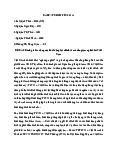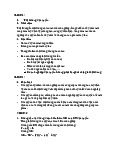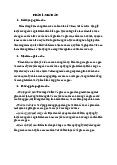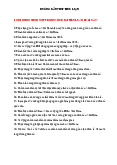





Preview text:
Chapter 2 I. True/False 1.
National income (NI) accounting allows us to assess the performance of the economy and make
polices to improve that performance . TRUE 2.
Gross domestic product measures at their market value the total output of all goods and services
produced in the economy during a year. FALSE – final goods and services 3.
GDP is a count of the physical quantity of output and is not a monetary measure. FALSE 4.
Final goods are consumption goods, capital goods, and service that are purchased by their end user
rather than being ones used for further processing or manufacturing. TRUE 5.
GDP includes the sale of intermediate goods and excludes the sales of final goods. FALSE – ngược lại 6.
The total value added to a product and the value of final product are equal. TRUE 7.
Social security payments and other public transfer payments are counted as part of GDP. FALSE 8.
The sale of stocks and bonds is excluded from GDP. TRUE 9.
In computing gross domestic product, private transfer payments are excluded because they do not
represent payment for currently produced goods and services. TRUE 10.
The two approaches to the measurement of the gross domestic product yield identical result because
one approaches measures the total amount spent on the products produced by business firms during a year
while the second approaches measures the total income of business firms during the year. FALSE – business => household 11.
Personal consumption expenditure only include expenditure for durable and nondurable goods.
FALSE – services and domestic plus foreign goods produced 12.
The expenditure made by a household to have a new home built is a personal consumption
expenditure. FALSE – công trình xây dựng tính vào gross private dosmetic investment 13.
In national income accounting, any increase in the inventories of business firm is included in
gross private domestic investment. TRUE 14.
Government purchase include spending by all units of government on the finished products of
business, but exclude all direct purchase of resources such as labor. FALSE – exclude transfer payments 15.
The net exports of an economy equal its exports of goods and services less its import of goods and services. TRUE 16.
The income approach to GDP includes compensation of employees, rents, interest income,
proprietor’s income, corporate profit, and taxes on production and imports. TRUE 17.
A GDP that has been deflated or inflated to reflect changes in the price level is called real GDP.
TRUE – GDP thực phản ánh mức giá đã được điều chỉnh giảm phát hoặc lạm phát 18.
To adjust nominal GDP for a given year to obtain real GDP. It is necessary to multiply (nhân)
nominal GDP by the price index (expressed in hundredths) for that year. FALSE – Real GDP = Nominal GDP / the price index 19.
If nominal GDP for an economy is $ 11.000 billion and the price index is 110, then real GDP is $10.000 billion. TRUE 20.
GDP is a precise measure of the economic well-being of society. FALSE – GDP was designed to
measure production capacity and economic growth. Đo năng lực sản xuất và tăng trưởng kinh tế, tổng sản lượng đầu ra 21.
The productive services of a homemaker (nội trợ) are included in GDP. FALSE II. Multiple choice 1.
Which is a primary use for national income accounting? A.
It provides a basis for assessing the performance of the economy. Nó tạo ra một cơ sở để đánh giá
hiệu suất hoạt động của nền kinh tế. B.
It measures economic efficiency in specific industries C.
It estimates expenditure on nonproduction transaction D.
It analyzes the cost of pollution to the economy 2.
Gross domestic product (GDP) is defined as A.
Personal consumption expenditure and gross private domestic investment B.
the sum of wage and salary compensation of employees, corporate profits, and interest income C.
The market value of final goods and services produced within a country in 1 year. D.
The market value of all final and intermediate goods and services produced by the economy in 1 year 3.
To include the value of the parts used in producing the automobiles turned out during a year in
gross domestic product for that year would be an example of A.
Including a nonmarket transaction B.
Including a nonproduction transaction C.
Including a noninvestment transaction D. Multiple counting 4.
Which of the following is a public transfer payment? A.
The social security benefit sent to a retired worker (trợ cấp bảo hiểm xã hội cho người đã nghỉ hưu) B.
The sale of shares of stock in Microsoft Corporation C.
The sale of a used (secondhand) toy house at a garage sale D.
The birthday gift of a check for $50 sent by a grandmother to her grandchild. 5.
The sale in year 2 of an automobile produced in year 1 would not be include in the gross
domestic product for year 2; doing so would involved A.
Including a nonmarket transaction B.
Including a nonproduction transaction C.
Including a noninvestment transaction D. Public transfer payments 6.
The service a babysitter performs when she stays at home with her baby brother while her
parents are out and for which she receives no payment is not included in the gross domestic product because A.
This is a nonmarket transaction – bởi vì không có sự trao đổi mua bán B.
This is a nonproduction transaction C.
This is noninvestment transaction D.
Multiple counting would be involved 7.
According to national income accounting, money income derived from the production of this year’s output is equal to A.
Corporate profits and the consumption of fixed capital B.
The amount spent to purchase this year’s total output C.
The sum of interest income and the compensation of employees D.
Gross private domestic investment less the consumption of fixed capital 8.
Which would be considered an investment according to economist? (Investment included:
machinery, equipment and tools, all construction, changes in inventories, creation of new capital assets) A.
The purchase of newly issued shares of stock in Microsoft B.
The construction of a new computer chip factory by intel C.
The resale of stock originally issued by the general electric corporation D.
The sale of a retail department store building by Sears to JCPenney 9.
A refrigerator was produced by its manufacturer in year 1, sold to a retailer in year 1, and sold
by the retailer to a final consumer in year 2. The refrigerator was A.
Counted as consumption in year 1 B. Counted as savings in year 1 C.
Counted as investment in year 1 D.
Not included in the gross domestic product of year 1 10.
The annual charge that estimates the amount of private capital equipment used up in each
year’s production is called A. Investment B. Depreciation C. Value added D. Multiple counting 11.
GDP in an economy is $3452 billion. Consumer expenditure are $2343 billion, government
purchases are $865 billion, and gross investment is $379 billion. Net exports are A. + $93 billion B. + $123 billion C. - $45 billion D. -$135 billion
Question 12 through 18 use the national income accounting data given in the following table Billions of dollars
Net private domestic investment $32 Personal taxes 39 Transfer payments 19
Taxes on production and imports 8 Corporate income taxes 11
Personal consumption expenditures 217 Consumption of fixed capital 7 U.S. exports 15 Dividends 15 Government purchases 51 Net foreign factor income 0
Undistributed corporate profits 10 Social Security contributions 4 U.S. imports 17 Statistical discrepancy 0 12.
Gross private domestic investment is equal to A. $32 billion B. $39 billion C. $45 billion D. $56 billion 13. Net export are equal to A. -$2 billion B. $2 billion C. -$32 billion D. $32 billion 14.
The gross domestic product is equal to A. $298 billion B. $302 billion C. $317 billion D. $ 305 billion 15.
The net domestic product is equal to A. $298 billion B. $302 billion C. $317 billion D. $321 billion 16. National income is equal to A. $ 245 billion B. $ 278 billion C. $ 298 billion D. $ 310 billion 17. Personal income is equal to A. $ 266 billion B. $ 284 billion C. $ 290 billion D. $ 315 billion 18. Disposable income is equal to A. 245 billion B. 284 billion C. 305 billion D. 321 billion 19.
Suppose nominal GDP rose from $500 billion to $600 billion while the GDP price index increase from 125 to 150. Real GDP A. Was constant B. Increased C. Decreased D.
Cannot be calculated from these figures 20.
In an economy, the total expenditure for a market basket of goods in year 1 (the base year) was
$4000 billion. In year 2, the total expenditure for the same market basket of goods was $4500 billion. What
was the GDP price index for the economy in year 2? =(4500/4000)x100=113 A. 0.88 B. 1.13 C. 188 D. 113 21.
Nominal GDP is less than real GDP in an economy in year 1. In year 2, nominal GDP is equal to real
GDP. In year 3, nominal GDP is slightly greater than real GDP. In year 4, nominal GDP is significantly
greater than real GDP. Which year is most likely to be the base year that is being used to calculate the price index for this economy A. 1 B. 2. C. 3 D. 4 22.
Nominal GDP was $3374 billion in year 1 and the GDP deflator was 108 and nominal GDP was
3989 in year 2 and the GDP deflator that year was 112. What was real GDP in years 1 and 2, respectively? A.
$3494 billion and $3562 billion. B.
$3339 billion and $3695 billion C.
$3595 billion and $3725 billion D.
$3643 billion and $4069 billion 23.
A price index one year was 145, and the next year it was 167. What is approximate percentage
change in the price level from one year to the next as measured by that index?[(167-145)/145]x100=15% A. 12% B. 13% C. 14% D. 15% III. Problem
1. Following are national income accounting figures Exports $367 Dividends 60
Consumption of fixed capital 307 Corporate profits 203
Compensation of employees 1,722 Government purchases 577 Rents 33
Taxes on production and imports 255
Gross private domestic investment 437 Corporate income taxes 88 Transfer payments 320 Interest 201 Proprietors’ income 132
Personal consumption expenditures 1,810 Imports 338
Social Security contributions 148
Undistributed corporate profits 55 Personal taxes 372 Net foreign factor income 0 Statistical discrepancy 0 Expenditure Approach Item Amount
_______________________ $________________
_______________________ $________________
_______________________ $________________
_______________________ $________________ Income Approach Item Amount
_______________________ $________________
_______________________ $________________
_______________________ $________________
_______________________ $________________
_______________________ $________________
_______________________ $________________
_______________________ $________________
_______________________ $________________




